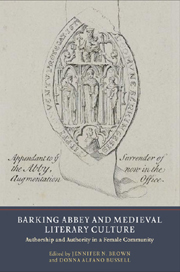Book contents
- Frontmatter
- Contents
- List of Contributors
- Acknowledgements
- List of Abbreviations
- Dedication
- Introduction: Barking's Lives, the Abbey and its Abbesses
- I BARKING ABBEY AND ITS ANGLO-SAXON CONTEXT
- II BARKING ABBEY AND ITS ANGLO-NORMAN CONTEXT
- III BARKING ABBEY AND THE LATER MIDDLE AGES
- Afterword. Barking and the Historiography of Female Community
- Bibliography
- Index
- YORK MEDIEVAL PRESS: PUBLICATIONS
Introduction: Barking's Lives, the Abbey and its Abbesses
Published online by Cambridge University Press: 05 April 2013
- Frontmatter
- Contents
- List of Contributors
- Acknowledgements
- List of Abbreviations
- Dedication
- Introduction: Barking's Lives, the Abbey and its Abbesses
- I BARKING ABBEY AND ITS ANGLO-SAXON CONTEXT
- II BARKING ABBEY AND ITS ANGLO-NORMAN CONTEXT
- III BARKING ABBEY AND THE LATER MIDDLE AGES
- Afterword. Barking and the Historiography of Female Community
- Bibliography
- Index
- YORK MEDIEVAL PRESS: PUBLICATIONS
Summary
In hoc etenim monasterio plura uirtutum sunt signa patrata, quae et ad memoriam aedificationemque sequentium ab his qui nouere descripta habentur a multis; e quibus et nos aliqua historiae nostrae ecclesiasticae inserere curauimus.
(‘In this monastery [at Barking] many miracles were performed which have been written down by those who were acquainted with them as an edifying memorial for succeeding generations and copies are in the possession of many people. Some of these we have taken care to insert into this History.’)
Barking Abbey's importance is attested in England's early recorded history, Historia ecclesiastica gentis Anglorum (c. 731), written by the monk known to us as the Venerable Bede. Bede's account of the miracles witnessed at the abbey, based on a now lost Barking libellus, gives us a glimpse of its first abbess, Ethelburg (d. 675), and other notable women who were associated with the abbey's founding (c. 666) or the life of its community. Bede records that Barking was founded by Erkenwald, abbot of Chertsey (Surrey) and later bishop of London (675), for his sister Ethelburg. Bede's history not only provides one of the earliest surviving accounts of the abbey, but also sheds light on the energy that the nuns of Barking put into the creation and circulation of their establishment narratives.
- Type
- Chapter
- Information
- Barking Abbey and Medieval Literary CultureAuthorship and Authority in a Female Community, pp. 1 - 30Publisher: Boydell & BrewerPrint publication year: 2012

